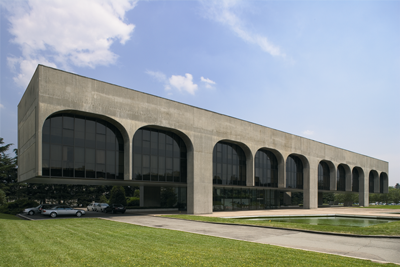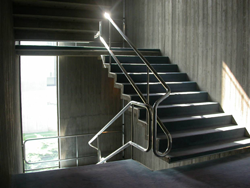You are in: Home page > Magazine Archive > Niemeyer in Turin. The Fata Building in Pianezza

Marzia Marandola
Niemeyer in Turin. The Fata Building in Pianezza
FATA, an acronym of “Fabbrica Automazione Trasporti e Affini”, is a company that destines its organisational services and machines for building to the international market. The new headquarters for its offices in Pianezza, just a few miles from Turin, therefore needed the instant persuasiveness of a TV commercial, suggesting an idea of solidity married to architectural modernity and up-to-date technology. As a result, in 1977, the project was placed in the hands of the Brazilian architect Oscar Niemeyer, who, just a few years earlier, with the Mondadori building in Segrate, had demonstrated the propagandist efficacy of architecture in diffusing the image of an industry that was modern, but able to cherish tradition. Right from Niemeyer’s first sketch a clear and definite idea emerged: The building, as bold and firm as a bridge, is a compact parallelepiped, narrow and long, raised from the ground on three pairs of mighty pillars, that bring rhythm to the façades. The image is one of a long main front, cut, again like the silhouette of a bridge, by generous depressed arches, all with the same profile. Unexpectedly, some of the arches’ piers are interrupted at the height of the first floor, while the others thrust vigorously into the ground. The central pillar marks the axis of symmetry, with respect to which, from both sides three arches aggregate up to the next pillar, while another two arches remain suspended cantilever-style, drawing an overall prospect linked by ten arches. Two stairwells, plastically modelled in concrete, are detached from the main volume, conquering it with a potent spatial three-dimensionality. The FATA building, its reinforced concrete structure completed in the truly remarkable span of around one year, is daunting due to the astounding suspension effect that makes it seem a genuine land bridge, with side overhangs of a good 21.30 metres, and inter-axes between the pillars of 32.40 metres.
Entrance is effected at ground floor level through a hall: a small yet sophisticated glass and steel box, where the technical/figurative thrift owes much to the lesson of elegant essentiality of Mies van der Rohe. Moving upstairs, the rough cast concrete walls close off the dry profile of the staircases with ramps jutting out from the walls, bound by a sinuous handrail in tubular metal. These lead to the large rooms that occupy the two main floors of the building, with open-plan offices.
But just how is this exceptional architectonic effect obtained that harmoniously welds opposites together, namely, the weightiness of the concrete block with the airy soaring of a viaduct?
The secret trick consists in the fact that the building’s two storeys do not rest on underlying structures, as normally happens in buildings, but have, so to speak, been hung. In effect, two mighty main beams, cast in pre-compressed cement, run along the crowning parallel to the extended front to bear the brunt of the weight of the lower floors. The two storeys, that is, the two floors of offices, have in fact been suspended on the main beam by means of an original system of tie-beams: this construction artifice makes it possible to have the office floors totally free of pillars and therefore organisable in total liberty, as well as cutting some pillars in mid-air, which function as tie-beams, stamping incredulity and levity on the building’s image.
The result, which marries maximum functionality of the internal spaces with an extraordinary constructional daring, translates into an original, modern architectonic image: this is the fruit of the collaboration of two great talents, gifted in different ways, and their mutual passion for reinforced concrete. One we have already mentioned, Niemeyer, whose predilection for concrete evokes the very words the FATA chose to comment: “Concrete is our favourite material: flexible, generous, suitable for any fantasy. To express these possibilities architecture must be varied, different, unforeseeable. Never repetitive, cold and rigid like structures in iron or wood. To this end, without bias, we modestly develop our projects made up of curves and straight lines, seeking that architectonic invention that is architecture itself for us. Technique and architecture are for us a necessary synthesis, two moments that are born together and together complete one another.”
The other is Riccardo Morandi, one of the most celebrated Italian engineers of the twentieth century, a builder of works that are awe-inspiring in their formal elegance and technical audaciousness, such as the 9 kilometre long viaduct on the Maracaibo lagoon in Venezuela from 1962. An authentic wizard of pre-compressed reinforced concrete, Morandi has been able to put himself in the service of an unconventional artistic idea, developing with wily originality a construction system focussed perfectly on the expressive figuration of the bridge, pursued right from the architect’s earliest sketches.
The actual construction of the work was entrusted to the Franco Borini firm from Turin that had to complete the building in the short time-scale of 210 consecutive solar days, as stipulated by the terms of contract. Building began on 1 September 1977; the structures in reinforced concrete were erected between May and November 1978, and when the work emerged from its dawning phase on its six imposing pillars, the inhabitants of Pianezza assumed that a road bridge was being built.
Construction was complex and demanded continual adroitness in the course of the work, above all to give in to the desire to leave the reinforced concrete unfinished, unplastered, on elements of such a huge size. The Florentine architect Massimo Gennari was the Italian referent for Niemeyer and it was he who oversaw the building works unceasingly during the years of construction, carrying out the executive project of the work and acting as go-between with FATA’s technical office and Morandi.
To employ the formworks the works management reserved itself to indicating the size of the boards, which had to be “…of planed pinewood treated with muriatic acid in order to bring out the pattern of the wood grain.” Inside the concrete skeleton, the two main office floors are screened from the long façade by continuous separators in anodized aluminium and double-glazing panes in tempered glass, bronze-coloured on the outside and transparent inside.¹ The transparency of the building’s long façades, broken up by the concrete arches, is contrasted by the short sides, which are completely blind. The short perspective, severe and silent, divulges the constructive elements of the building’s skeleton: in fact it is possible to read, in the horizontal sections, the breadth of the storeys, the pillar/tie-beams and the metal joints.
This compositional choice, which brings out the construction filigree of the building’s short side, is to be attributed to Morandi, who, to avoid problems of splitting, cut into the walls at the level of the internal floors to create the necessary structural joins.
As ever, for the great engineer, constructive necessities are married poetically to aesthetic exigencies, and thanks to a combination of exceptional skill and professionalism the Fata headquarters still displays today the architectural project’s extraordinary construction quality and extreme creative modernity.
Note
¹ For more details see M. Marandola, La sede per gli uffici FATA di Pianezza (Torino) di Oscar Niemeyer e Riccardo Morandi (1976-79) in “Casabella”, 764, marzo 2008, pp.6-25 e Idem, La Costruzione in precompresso. Conoscere per recuperare il patrimonio italiano, Sole24ore, Milano 2009, pp.107-122.















